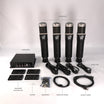Corner-Balancing

Too Long; Didn’t Read Version
Corner balancing your 4-actuator motion system is very important – it will help optimize the performance of your motion as well as ensure maximum longevity of your actuators.
After some driving, simply place your hands on the rear actuator motors – they should feel pretty equal in temperature. If one is significantly hotter than the other, balancing should be performed.
Make approximately 1/16” (1.5mm) thick shims – can be of any material – and place one shim between the floor and the actuator foot of the COOLER actuator. Drive for 20 minutes, then re-check the temperature of the rear actuators.
Add another shim under the cooler actuator if necessary until both actuators feel balanced in temperature. Precise temperature measurements are not necessary.
Check again after 1 month.
Full Technical Document Version
If you’ve ever noticed 1 of the actuator motors (usually 1 of the rear motors) feeling much hotter to the touch than the other 3, this is usually an indication that your chassis is unbalanced.
It’s very important to properly corner balance your motion simulator. This will ensure the following benefits:
- The performance (speed, acceleration and response) of your motion system is maximized.
- The life of your motion system is maximized.
Let’s begin by trying to understand why this is happening, and why it’s such a common problem especially with 4-actuator systems. In 3D space, any 2 points form a line, while any 3 points form a plane. This means with any 4 point systems – such as a car and its 4 wheels, 1 point is redundant and not is not sitting on the plane formed by the other 3 points. This is because no matter how precisely a 4-point system is manufactured, there will always be built in tolerances/errors in a real-world mechanical system.

Figure 1 – I feel like I need to insert an image here to make this article appear more sophisticated than it really is.
So why don’t we see cars going around tripodding everywhere? Because the chassis flexes, suspension bushings deform, suspension springs compress, and tires stretch. However, even though we have 4 wheels on the ground (usually), it doesn’t mean the corner weights are balanced. Corner weight balancing is a very important and fundamental topic of racecar tuning.

Figure 2 – Not all cars have 4 wheels on the ground.
On a typical aluminum-extruded, 4-actuator motion simulator, there is very little flex compared to a car. Without suspension bushings and springs, or tires, the simulator is nearly a complete rigid body. This is the main reason why your DK2 actuators come with a 1/8” (3mm) rubber pad at the bottom of each foot. Not only will the rubber pads save your beautiful hardwood flooring, they introduce some flex to your simulator.

Figure 3 – An excellent example of flooring we don’t want to destroy with our DK2.
Generally, there are 3 places where your motion simulator permits flex:
- The slight bending of the aluminum-extruded chassis and joints.
- The 1/8” (3mm) actuator rubber pads.
- Floor material such as carpet or tiles.
Our goal is to try our best to get the 4 points of contact well within the permitted flex of your motion simulator.
Obviously, the “proper” way to do this is follow what race teams do; but since most people don’t have access to a fancy corner-weight system, we will focus on a less scientific but much easier and faster method.

Figure 4 – This is a great example of what we will not be discussing today.
Let’s get in your simulator, fire up the DK2, and go for a few laps! Try using a track with a more balanced left and right-hand turns. After 20 minutes of driving, carefully place your hands on the 2 rear actuator motors. If one of them feels significantly hotter than the other, some balancing is needed.
Make some shim pads using any material, roughly 1/16” (1.5mm) in thickness. Place 1 of these amazing shim pads you made between the floor and the bottom of the COOLER actuator. Jump back in the seat and drive another 20min – and add another awesome shim pad if necessary.
Repeat this process until both motors are equal in temperature by feel. There is no need to take out your fancy infrared thermometer (I know you have one) because different cars, tracks, and games will produce different results. Our goal is to get close, that’s all. The DK2 actuators are overbuilt to last a very long time.

Figure 5 – Sigma Integrale’s corner-balancing system (CBS) – Patent Pending.
What you are actually doing by going through this process is balancing your diagonal weights, or Cross Weights. When the cross weights are equal, the chassis is balanced and no longer tripodding:
Cross Weight
= Front Left Corner Weight + Rear Right Corner Weight
= Front Right Corner Weight + Rear Left Corner Weight.
In other words:

Figure 6 – Sigma DK2 Axis #s.
Axis 1 + Axis 3 = Axis 2 + Axis 4
That’s it! You’re all done! Please check again after 1 month, after your simulator has settled and broken-in on the shims. If the 2 rear motors both feel warm to the touch, and roughly equal to each other, no additional work is required.
Teknic Motor Software Application Download








